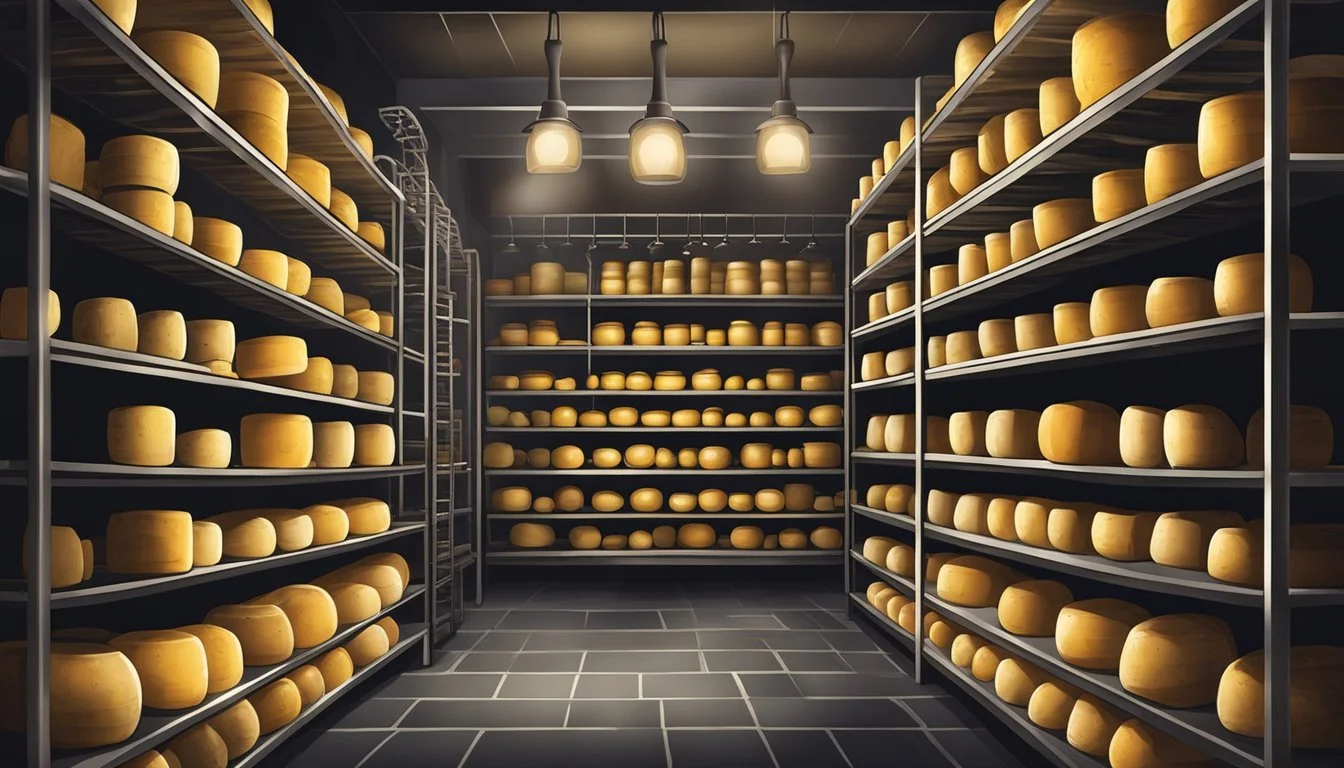How Long Does Gouda Last?
Shelf Life and Storage Tips
Gouda cheese, a popular semi-hard cheese originating from the Netherlands, is known for its rich, unique flavor and smooth texture. The shelf life of Gouda varies depending on several factors, including whether it is purchased sliced, in chunks, or shredded, and its state of being opened or unopened. In general, unopened semi-hard chunks of Gouda cheese can be safely stored in the refrigerator for up to two months, whereas sliced Gouda has a shorter shelf life of about one month. Once the packaging is opened, the timeframe for maintaining its freshness decreases.
The longevity of Gouda cheese in an opened state depends on the type, with semi-hard varieties typically lasting up to two weeks, between-soft-and-hard types remaining good for up to three weeks, and hard versions of Gouda cheese potentially lasting up to six weeks when stored correctly in the refrigerator. To optimize its shelf life, it is advisable to wrap the cheese in parchment or wax paper before placing it in an airtight container, thus preventing it from absorbing any unwanted odors from the refrigerator and retaining its original flavor.
For extended storage, Gouda cheese can also be kept in the freezer, where it can maintain the best quality for approximately two months. Although freezing can prolong the safety of the cheese indefinitely, it may somewhat alter the texture and flavor. To experience Gouda cheese at its best, it's important to consider these storage methods and timelines, ensuring that this flavorful cheese is enjoyed at its peak quality.
Understanding Gouda Cheese
Gouda cheese, a staple of Dutch origin, varies widely in taste and texture depending on its age and the specific type. This section addresses its origins and how the aging process affects the different types of Gouda.
Origins and Types
Gouda cheese originates from the Netherlands and is one of the most popular cheeses worldwide. It falls into the semi-hard cheese category and comes in a range of ages, each offering a distinct flavor and texture. Noord-Hollandse Gouda, a variety that is protected with a Protected Geographical Indication status, ensures that only cheese from this region can carry its name. There are various types of Gouda, characterized mainly by their age:
Young Gouda: Aged for a few weeks; it has a mild, creamy taste.
Aged Gouda: Also known as 'Old Gouda', this type is aged for several months to over a year, resulting in a stronger flavor and firmer texture.
Aging Process
The aging process is crucial for developing Gouda's distinctive taste and character. Freshly made Gouda begins as a semi-soft cheese, but as it ages, it loses moisture and hardens. Over time, the flavors intensify, and the texture can vary from semi-hard to almost crumbly with age. The stages of Gouda aging are:
Young: 4 weeks
Young Matured: 8-10 weeks
Matured: 16-18 weeks
Extra Matured: 7-8 months
Old Gouda: 10-12 months or more
Each stage not only marks a progression in flavor and texture but also in color, with the cheese becoming darker as it matures.
Proper Storage Conditions
For Gouda cheese to maintain its quality and shelf life, understanding and implementing proper storage conditions are essential. These conditions hinge on maintaining the right temperature and moisture levels and choosing suitable storage containers.
Temperature and Moisture Control
The refrigerator provides an ideal setting for storing Gouda cheese, as it can maintain a consistent temperature and humidity level. Gouda cheese should be kept in the cheese drawer or crisper, where these conditions are most stable. The optimal temperature range for storing Gouda cheese is between 35-40°F (1.7-4.4°C).
Wax or parchment paper: Encasing Gouda cheese in wax or parchment paper allows it to breathe, thus preventing moisture buildup that could encourage mold growth.
Avoid plastic wrap for long-term storage: Plastic wrap can suffocate cheese, affecting its flavor and texture adversely over time.
Best Containers for Storage
Selecting an appropriate container is crucial to extend the freshness of Gouda once it has been opened.
Airtight containers: For shredded Gouda, or once the original packaging is compromised, transferring the cheese to an airtight container is advisable to prevent it from absorbing odors and moisture from the fridge.
Cheese paper or aluminum foil: If an airtight container is not used, one can also wrap Gouda in cheese paper or aluminum foil to protect it from the environment and maintain its moisture content.
Using these storage techniques ensures that Gouda cheese remains fresh for its maximal shelf life while preserving its distinctive flavor and texture.
Maximizing Shelf Life
Proper storage is crucial for extending the shelf life of Gouda cheese and maintaining its quality. Techniques vary depending on whether one is storing Gouda in the refrigerator or freezer, and each method has its best practices.
Refrigerated Storage
Gouda Cheese should be kept refrigerated at a temperature between 35°F to 45°F to ensure optimal quality. Upon purchase, one should:
Wrap the cheese in parchment or wax paper, then in plastic wrap or aluminum foil to prevent it from absorbing other flavors in the fridge.
Store in an area of the refrigerator with a consistent temperature, avoiding the coldest parts where the cheese might over-harden.
The shelf life for different types of Gouda in the refrigerator varies:
Type Duration Unopened semi-hard Gouda Up to 2 months Sliced Gouda (unopened) Up to 1 month Semi-hard Gouda (opened) 2 to 3 weeks Between soft and hard Gouda (opened) Up to 3 weeks Hard Gouda (opened) Up to 6 weeks
If mold is observed on the Gouda cheese, one can cut off at least an inch around and below the moldy spot and consume the remaining cheese.
Freezing and Thawing Procedures
Freezing Gouda cheese can extend its shelf life, but one should:
Wrap tightly in parchment or wax paper, then place in a freezer bag or airtight container to prevent freezer burn and flavor transfer.
Label the package with the freezing date for future reference.
While Gouda can be frozen for up to two months, here are some steps to follow when thawing:
Thaw the cheese in the refrigerator for several hours or overnight to maintain texture and flavor.
After thawing, consume the cheese as soon as possible for best quality and to ensure food safety.
Identifying Spoilage
In recognizing when Gouda cheese has gone bad, visual and olfactory evaluations are crucial. They should promptly discard any Gouda showing signs of spoilage to avoid health risks.
Visual and Olfactory Signs
Visual Indicators:
Mold: Look for any unusual spots or fuzzy growths, which indicate mold. While some cheeses have edible molds, unwanted mold on Gouda can be harmful.
Discoloration: If the cheese exhibits dark or unnatural colors compared to its usual creamy yellow hue, it's a clear sign of spoilage.
Texture Changes: Spoiled Gouda may become exceptionally hard or develop a slimy feel.
Olfactory Indicators:
Off Odor: A sour or ammonia-like smell is a strong indication that the Gouda cheese is no longer edible.
Unpleasant Odor: Any odor that deviates from Gouda's typically mild and creamy scent should be considered a warning sign of spoilage.
Health Risks of Spoiled Cheese
Eating spoiled Gouda cheese poses several health risks, as it can harbor harmful bacteria and toxins:
Foodborne Illness: Bacteria such as Salmonella, Listeria, and E. coli can grow on spoiled cheese, leading to food poisoning.
Allergic Reactions: Some molds on cheese produce substances that may trigger allergic responses or respiratory problems.
Consumers should practice caution and discard any cheese there is uncertainty about its condition. Regular checks for spoilage can serve as a simple but effective protection against consuming spoiled foods and facing health-related consequences.
Uses and Pairings
Gouda cheese is not only versatile in its applications, but also enhances a wide array of dishes with its unique flavor profile, ranging from mild to sharp depending on aging. It complements various foods and can be incorporated into both hot meals and serves as a substantial element in cold presentations.
Culinary Applications
One can utilize Gouda in multiple culinary applications due to its semi-hard texture which is optimal for melting. Gouda is perfect for grilled cheese sandwiches, where its creaminess contributes to a satisfying melt. In pizza or mac and cheese, Gouda adds a rich, deep flavor. Its adaptability is also evident when used in cooked dishes, holding its own when combined with strong flavors, or contributing a subtle cheesy essence in more delicately seasoned recipes.
Cooking: Ideal for melting
Grilled Cheese Sandwich
Pizza
Mac and Cheese
Cooked Dishes: Complements strong and delicate flavors
Pairing with Other Foods
When considering pairing with other foods, Gouda shows its flexibility. In its younger form as a fresh cheese, it provides a milder taste perfect for snacking. More mature variations of Gouda, such as smoked Gouda, deliver a robust flavor, excellent when sliced on a charcuterie board. Each type of Gouda pairs well with certain foods, enhancing the overall dining experience.
Snacking: Young, fresh Gouda is preferable
Charcuterie (What wine goes well with charcuterie?) Board: Smoked and aged Gouda is more suitable
In summary, Gouda's melting properties make it a prime candidate for heated dishes, and its flavor spectrum from sweet and mild to smoky and bold allows it to be the cheese of choice for various pairings.
Cheese Care and Handling
In ensuring that Gouda cheese maintains its quality and freshness, proper storage and handling are vital. Protection from elements that can degrade its integrity, such as light and improper packaging, is essential.
Serving and Preservation
Serving: When presenting Gouda cheese on a cheese board, it should be served at room temperature to enhance its flavor and texture. Before serving, the cheese should be taken out of the refrigerator and allowed to warm up for about an hour.
Preservation: To preserve the quality of Gouda cheese, it needs to be stored at a consistent temperature between 35-45°F (1.7-7.2°C). It should be kept in a part of the refrigerator that maintains a balanced humidity level. Packaging plays a significant role in preservation; semi-hard chunks of Gouda should be wrapped in parchment or wax paper to protect them from absorbing fridge odors and to allow the cheese to breathe, thus preventing mold growth. Shredded Gouda must be placed in an airtight container to retain freshness.
Leftovers and Reuse
Leftovers: After being served, any leftover Gouda cheese should be quickly rewrapped using the same protective materials. For Gouda cheese that has been sliced, it's crucial to ensure that it is sealed properly to minimize exposure to air, which can accelerate spoilage.
Reuse: If Gouda cheese develops a small amount of mold, one can cut around the moldy part before consuming the rest. However, if the cheese is overtaken by mold or has a foul smell or flavor, it should be discarded. Leftover Gouda, if kept properly, can be reused in various dishes, such as melted in sandwiches or grated over pasta dishes, adding a rich, creamy taste.






